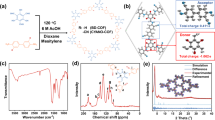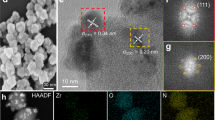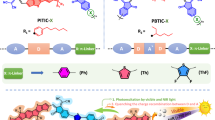Abstract
Organic semiconductors are attractive photocatalysts, but their quantum yields are limited by the transfer of photogenerated charges to the surface. A promising strategy for low-loss charge transfer is to shorten the distance from the bulk exciton coupling region to the catalyst surface. Here we employ the hydrogen-bonded organic framework 1,3,6,8-tetrakis(p-benzoic acid)pyrene (HOF-H4TBAPy) with hydrophilic one-dimensional micropore channels as a proof of concept for this approach. Under irradiation, photogenerated excitons rapidly transfer to the inner surface of adjacent micropores, engendering a mere 1.88 nm transfer route, thus significantly improving exciton utilization. When the micropore channel length does not exceed 0.59 μm, the sacrificial photocatalytic H2 evolution rate of HOF-H4TBAPy reaches 358 mmol h−1 g−1 and the apparent quantum yield at 420 nm is 28.6%. We further demonstrated a stable 1.03 mol day−1 m−2 H2 evolution on a 0.5 m2 HOF-H4TBAPy-loaded fibre under 1 Sun irradiation.

This is a preview of subscription content, access via your institution
Access options
Access Nature and 54 other Nature Portfolio journals
Get Nature+, our best-value online-access subscription
$29.99 / 30 days
cancel any time
Subscribe to this journal
Receive 12 digital issues and online access to articles
$119.00 per year
only $9.92 per issue
Buy this article
- Purchase on Springer Link
- Instant access to full article PDF
Prices may be subject to local taxes which are calculated during checkout





Similar content being viewed by others
Data availability
The data that support the findings of this study are presented in the text and Supplementary Information. Additional data and information are available from the corresponding author on request. Source data are provided with this paper.
References
Lin, L. et al. Molecular-level insights on the reactive facet of carbon nitride single crystals photocatalysing overall water splitting. Nat. Catal. 3, 649–655 (2020).
Kosco, J. et al. Enhanced photocatalytic hydrogen evolution from organic semiconductor heterojunction nanoparticles. Nat. Mater. 19, 559–565 (2020).
Weingarten, A. S. et al. Self-assembling hydrogel scaffolds for photocatalytic hydrogen production. Nat. Chem. 6, 964–970 (2014).
Wang, Y. et al. Current understanding and challenges of solar-driven hydrogen generation using polymeric photocatalysts. Nat. Energy 4, 746–760 (2019).
Sprick, R. S. et al. Tunable organic photocatalysts for visible-light-driven hydrogen evolution. J. Am. Chem. Soc. 137, 3265–3270 (2015).
Wang, H. et al. An excitonic perspective on low-dimensional semiconductors for photocatalysis. J. Am. Chem. Soc. 142, 14007–14022 (2020).
Sun, C. et al. Interface design for high-efficiency non-fullerene polymer solar cells. Energy Environ. Sci. 10, 1784–1791 (2017).
Mikhnenko, O. V., Blom, P. W. M. & Nguyen, T. Q. Exciton diffusion in organic semiconductors. Energy Environ. Sci. 8, 1867–1888 (2015).
Liu, A. et al. Panchromatic ternary polymer dots involving sub-picosecond energy and charge transfer for efficient and stable photocatalytic hydrogen evolution. J. Am. Chem. Soc. 143, 2875–2885 (2021).
Woods, D. J., Sprick, R. S., Smith, C. L., Cowan, A. J. & Cooper, A. I. A solution-processable polymer photocatalyst for hydrogen evolution from water. Adv. Energy Mater. 7, 1700479 (2017).
Kosco, J. et al. Generation of long-lived charges in organic semiconductor heterojunction nanoparticles for efficient photocatalytic hydrogen evolution. Nat. Energy 7, 340–351 (2022).
Wang, X. et al. Sulfone-containing covalent organic frameworks for photocatalytic hydrogen evolution from water. Nat. Chem. 10, 1180–1189 (2018).
Zhang, W. et al. Reconstructed covalent organic frameworks. Nature 604, 72–79 (2022).
Pachfule, P. et al. Diacetylene functionalized covalent organic framework (COF) for photocatalytic hydrogen generation. J. Am. Chem. Soc. 140, 1423–1427 (2018).
Yang, S. et al. Transformation of covalent organic frameworks from N-acylhydrazone to oxadiazole linkages for smooth electron transfer in photocatalysis. Angew. Chem. Int. Ed. 61, e202115655 (2022).
Wang, B., Lin, R. B., Zhang, Z., Xiang, S. & Chen, B. Hydrogen-bonded organic frameworks as a tunable platform for functional materials. J. Am. Chem. Soc. 142, 14399–14416 (2020).
Aitchison, C. M. et al. Photocatalytic proton reduction by a computationally identified, molecular hydrogen-bonded framework. J. Mater. Chem. A 8, 7158–7170 (2020).
Yin, Q. et al. An ultra-robust and crystalline redeemable hydrogen-bonded organic framework for synergistic chemo-photodynamic therapy. Angew. Chem. Int. Ed. 57, 7691–7696 (2018).
Feng, J. F., Liu, T. F. & Cao, R. An electrochromic hydrogen-bonded organic framework film. Angew. Chem. Int. Ed. 59, 22392–22396 (2020).
Zhao, W. et al. Using sound to synthesize covalent organic frameworks in water. Nat. Synth. 1, 87–95 (2022).
Bai, Y. et al. Accelerated discovery of organic polymer photocatalysts for hydrogen evolution from water through the integration of experiment and theory. J. Am. Chem. Soc. 141, 9063–9071 (2019).
Wiitala, K. W., Hoye, T. R. & Cramer, C. J. Hybrid density functional methods empirically optimized for the computation of 13C and 1H chemical shifts in chloroform solution. J. Chem. Theory Comput. 2, 1085–1092 (2006).
Seifrid, M., Reddy, G. N. M., Chmelka, B. F. & Bazan, G. C. Insight into the structures and dynamics of organic semiconductors through solid-state NMR spectroscopy. Nat. Rev. Mater. 5, 910–930 (2020).
Le Bahers, T., Adamo, C. & Ciofini, I. A qualitative index of spatial extent in charge-transfer excitations. J. Chem. Theory Comput. 7, 2498–2506 (2011).
Hestand, N. J. et al. Extended-charge-transfer excitons in crystalline supramolecular photocatalytic scaffolds. J. Am. Chem. Soc. 138, 11762–11774 (2016).
Yang, L. et al. Combining photocatalytic hydrogen generation and capsule storage in graphene based sandwich structures. Nat. Commun. 8, 1–7 (2017).
Guo, Y., Dai, B., Peng, J., Wu, C. & Xie, Y. Electron transport in low dimensional solids: a surface chemistry perspective. J. Am. Chem. Soc. 141, 723–732 (2019).
Spano, F. C. The spectral signatures of Frenkel polarons in H- and J-aggregates. Acc. Chem. Res. 43, 429–439 (2010).
Kazantsev, R. V. et al. Molecular control of internal crystallization and photocatalytic function in supramolecular nanostructures. Chem 4, 1596–1608 (2018).
Jin, X.-H. et al. Long-range exciton transport in conjugated polymer nanofibers prepared by seeded growth. Science 360, 897–900 (2018).
Pinto, R. M. et al. Effect of molecular stacking on exciton diffusion in crystalline organic semiconductors. J. Am. Chem. Soc. 137, 7104–7110 (2015).
Yu, J., Park, J., Van Wyk, A., Rumbles, G. & Deria, P. Excited-state electronic properties in Zr-based metal–organic frameworks as a function of a topological network. J. Am. Chem. Soc. 140, 10488–10496 (2018).
Flanders, N. C. et al. Large exciton diffusion coefficients in two-dimensional covalent organic frameworks with different domain sizes revealed by ultrafast exciton dynamics. J. Am. Chem. Soc. 142, 14957–14965 (2020).
Chandrabose, S. et al. High exciton diffusion coefficients in fused ring electron acceptor films. J. Am. Chem. Soc. 141, 6922–6929 (2019).
Wiesenhofer, H. et al. Limitations of the Förster description of singlet exciton migration: the illustrative example of energy transfer to ketonic defects in ladder-type poly(para-phenylenes). Adv. Funct. Mater. 15, 155–160 (2005).
Murthy, D. H. K. et al. Origin of the overall water splitting activity of Ta3N5 revealed by ultrafast transient absorption spectroscopy. Chem. Sci. 10, 5353–5362 (2019).
Tachibana, Y., Vayssieres, L. & Durrant, J. R. Artificial photosynthesis for solar water-splitting. Nat. Photonics 6, 511–518 (2012).
Li, L., Kazoe, Y., Mawatari, K., Sugii, Y. & Kitamori, T. Viscosity and wetting property of water confined in extended nanospace simultaneously measured from highly-pressurized meniscus motion. J. Phys. Chem. Lett. 3, 2447–2452 (2012).
Kosco, J. et al. The effect of residual palladium catalyst contamination on the photocatalytic hydrogen evolution activity of conjugated polymers. Adv. Energy Mater. 8, 1802181 (2018).
Li, L. et al. Rational design of porous conjugated polymers and roles of residual palladium for photocatalytic hydrogen production. J. Am. Chem. Soc. 138, 7681–7686 (2016).
Nørskov, J. K. et al. Origin of the overpotential for oxygen reduction at a fuel-cell cathode. J. Phys. Chem. B 108, 17886–17892 (2004).
Wang, S. et al. A robust large-pore zirconium carboxylate metal–organic framework for energy-efficient water-sorption-driven refrigeration. Nat. Energy 3, 985–993 (2018).
Cho, K. H. et al. Rational design of a robust aluminum metal-organic framework for multi-purpose water-sorption-driven heat allocations. Nat. Commun. 11, 11–18 (2020).
Hisatomi, T. & Domen, K. Reaction systems for solar hydrogen production via water splitting with particulate semiconductor photocatalysts. Nat. Catal. 2, 387–399 (2019).
Wang, Z. et al. Overall water splitting by Ta3N5 nanorod single crystals grown on the edges of KTaO3 particles. Nat. Catal. 1, 756–763 (2018).
Moss, B. et al. Linking in situ charge accumulation to electronic structure in doped SrTiO3 reveals design principles for hydrogen-evolving photocatalysts. Nat. Mater. 20, 511–517 (2021).
Hu, H. et al. Metal–organic frameworks embedded in a liposome facilitate overall photocatalytic water splitting. Nat. Chem. 13, 358–366 (2021).
Liu, J. et al. Metal-free efficient photocatalyst for stable visible water splitting via a two-electron pathway. Science 347, 970–974 (2015).
Zhao, D. et al. Boron-doped nitrogen-deficient carbon nitride-based Z-scheme heterostructures for photocatalytic overall water splitting. Nat. Energy 6, 388–397 (2021).
Perdew, J. P., Burke, K. & Ernzerhof, M. Generalized gradient approximation made simple. Phys. Rev. Lett. 78, 1396–1396 (1997).
Krukau, A. V., Vydrov, O. A., Izmaylov, A. F. & Scuseria, G. E. Influence of the exchange screening parameter on the performance of screened hybrid functionals. J. Chem. Phys. 125, 1–5 (2006).
Schäfer, A., Horn, H. & Ahlrichs, R. Fully optimized contracted Gaussian basis sets for atoms Li to Kr. J. Chem. Phys. 97, 2571–2577 (1992).
Frisch, M. J. et al. Gaussian 16 revision B.01 (Gaussian Inc., 2016).
Ma, J., Zhang, X., Basarić, N. & Phillips, D. L. Direct observation of photoinduced ultrafast generation of singlet and triplet quinone methides in aqueous solutions and insight into the roles of acidic and basic sites in quinone methide formation. J. Am. Chem. Soc. 139, 18349–18357 (2017).
Lu, T. & Chen, F. Multiwfn: a multifunctional wavefunction analyzer. J. Comput. Chem. 33, 580–592 (2012).
Acknowledgements
This work was supported by the National Science Foundation of China (21872077), the National Key Research and Development Project of China (2020YFA0710304) and the Collaborative Innovation Center for Regional Environmental Quality. We thank Y. Weng, Z. Wang and Y. Xu (all IOP) for their support on the transient absorption spectroscopy tests. We are grateful to R. Zong, S. Yue and C. Ma (THU, Analysis Center) for their help with the electron microscopic analysis. We are also very grateful to E. Zhu (JLNU) for his useful suggestions in organic synthesis. Finally, we thank S. Yang, D. Wang (IMU) and Y. Guo (HNU) for their technical work in constructing outdoor photocatalytic systems.
Author information
Authors and Affiliations
Contributions
Y.G., Y.Z. and Q.Z. co-proposed the idea and designed the experiments. Y.G. carried out the route design of organic synthesis and the sample synthesis. Y.G. and Q.Z. performed the ultrafast spectroscopic measurements and analysed the data. Y.G. performed the DFT calculations. Q.Z. carried out the crystal engineering design and physical modelling. Y.G and Q.Z. co-analysed the results. Y.G. and Y.Z. supervised the project. All the authors discussed the results and contributed to the writing of the paper.
Corresponding authors
Ethics declarations
Competing interests
The authors declare no competing interests.
Peer review
Peer review information
Nature Catalysis thanks Robert Godin for their contribution to the peer review of this work.
Additional information
Publisher’s note Springer Nature remains neutral with regard to jurisdictional claims in published maps and institutional affiliations.
Supplementary information
Supplementary Information
Supplementary Methods, Figures 1–58, Notes 1–6, Tables 1–11 and References 1–78.
Supplementary Video 1
A plate reactor evolving and expelling H2 gas bubbles under an Xe lamp array (irradiation intensity: ~100 mW cm−2).
Supplementary Video 2
A plate reactor evolving and expelling H2 gas bubbles under natural sunlight (irradiation intensity: ~12.2 mW cm−2).
Supplementary Video 3
Nucleation of H2 bubbles on a non-woven fabric loaded with HOF under irradiation from a Xe lamp.
Supplementary Data 1
DFT atomic coordinates of the H4TBAPy molecule.
Supplementary Data 2
DFT atomic coordinates of a HOF crystal.
Source data
Source Data Fig. 1
Source data involved in Fig. 1.
Source Data Fig. 2
Source data involved in Fig. 2.
Source Data Fig. 3
Source data involved in Fig. 3.
Source Data Fig. 4
Source data involved in Fig. 4.
Source Data Fig. 5
Source data involved in Fig. 5.
Rights and permissions
Springer Nature or its licensor (e.g. a society or other partner) holds exclusive rights to this article under a publishing agreement with the author(s) or other rightsholder(s); author self-archiving of the accepted manuscript version of this article is solely governed by the terms of such publishing agreement and applicable law.
About this article
Cite this article
Zhou, Q., Guo, Y. & Zhu, Y. Photocatalytic sacrificial H2 evolution dominated by micropore-confined exciton transfer in hydrogen-bonded organic frameworks. Nat Catal 6, 574–584 (2023). https://doi.org/10.1038/s41929-023-00972-x
Received:
Accepted:
Published:
Issue Date:
DOI: https://doi.org/10.1038/s41929-023-00972-x
This article is cited by
-
Vitrification-enabled enhancement of proton conductivity in hydrogen-bonded organic frameworks
Nature Communications (2024)
-
Stable hydrogen-bonded organic frameworks and their photo- and electro-responses
Nano Research (2024)
-
Single-atomic activation on ZnIn2S4 basal planes boosts photocatalytic hydrogen evolution
Nano Research (2024)



